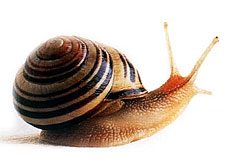Gourmets’ answer to fast food wins converts in Switzerland

Thousands of Swiss are embracing "Slow Food" - the opposite of its American-inspired cousin - which stresses the importance of putting the palate first.
The movement, founded in Paris in 1989, aims to reinforce the idea that good food needs time to prepare and time to savour.
In 1986, the US fast food chain McDonald’s tried to open its first restaurant in Rome. The chosen location was within spitting distance of the world famous “Spanish Steps” on the Piazza Navona.
A Piedmont journalist, Carlo Petrini, nearly choked when he got wind of the application, and helped to save the Spanish Steps from sharing the limelight with the ubiquitous double arches.
He also decided that enough fast food was enough, and in 1989 the concept of “Slow Food” – and the organisation – was born, with Petrini as its president, and a snail as its logo.
The idea of re-creating a culture around the enjoyment of food and wine was hardly a revelation in Italy, where even a bowl of pasta and a glass of cheap wine are prepared and savoured with the appropriate time and care (pasta – even “al dente” – needs at least eight minutes).
But the idea of Slow Food also proved irresistible to others, and today the movement has 70,000 members in 42 countries – 2,000 of whom are in Switzerland.
More than survival
The enjoyment of food is an important part of life, says Rafael Pérez, Slow Food president in German-speaking Switzerland. He suggests that if one doesn’t savour food, it becomes like a drug to an addict – something one takes merely in order to survive.
Pérez describes Slow Food members as “ecological gourmets”, who respect the seasons, and shun convenience if it is at the expense of taste.
To really enjoy food and drink, he told swissinfo, you need fresh produce – which means locally produced, rather than imported – and to steer well clear of ready-made meals.
For Pérez Slow Food is also about preserving a culinary tradition. “Slow Food will prevent traditional recipes and practices – which have sustained us for generations – from disappearing.
“We are trying to prevent the homogenising of flavour, because that will eventually weaken or destroy our ability to taste and appreciate flavours and their subtleties.
Wider ambitions
The success of Slow Food in attracting adherents has led the movement to widen its ambitions, and campaign for better working conditions for farmers and labourers, and to promote organic agriculture.
One technique is the Slow Food Award for the Defence of Biodiversity, which offers cash incentives to farmers, as well as publicity to help conscientious producers promote their produce.
Not surprisingly, Slow Food is no friend of genetically modified (GM) crops. “Money is made available for GM research but no effort is spent on finding out whether traditional crops have similar properties,” says Pérez.
“Why spend money on GM when we don’t even know how many strains there are in canton Valais [for example] and what benefits these might bring?”
Too expensive
One criticism levelled at Slow Food is that products that fulfil its criteria – such as organic produce – are typically far more expensive than crops produced by traditional methods.
Pérez takes the view that the question is proof of how our attitudes to food have changed – for the worse.
“It depends on how important food is for our culture,” he told swissinfo. “Just a few generations ago, people spent almost half of their income on food. Today that figure is more like ten to 15 per cent [because] we prefer spending money on clothes, cars and holidays.”
Young hearts hard to win
Slow Food members typically tend to be aged from 30 to 60. Young people – in Switzerland at least – are less interested, and persuading them to take food seriously is next to impossible, says Luca Cavadini, Slow Food president in Italian-speaking canton Ticino.
“In Switzerland, schools don’t inform pupils about the value and importance of food,” he says “In Italy, by contrast, the subject is taken much more seriously.”
Indeed, Slow Food has published a school textbook in Italy, Cavadini adds, with a trace of bitterness.
Hygiene worries
Slow Food might be proving appetising to some, but the movement says their aims are being undermined by what they see as a hysterical quest to standardise food production methods by the United States and the European Union, chiefly in the interests of hygiene.
Cheese production methods are a good example. Small producers in Europe are having particular difficulties with directives from Brussels, which is laying down tough rules on hygiene.
To fight its corner, Slow Food has taken the battle directly to Brussels. It has an office charged with countering what it sees as the European Commission’s often absurd rules and regulations.
swissinfo, Jean-Michel Berthoud
Slow Food has 70,000 members in 42 countries.
Some 2,000 are in Switzerland.
The movement has an office in Brussels which lobbies the EU.
It produces a school textbook for Italian children.
Slow Food was founded by a Piedmont journalist, Carlo Petrini, in 1989 after he helped to prevent McDonald’s from opening a restaurant near Rome’s Spanish Steps.
Today the movement has 70,000 members in 42 countries – 2,000 of whom are in Switzerland.
Slow Food has since widened its ambitions, and campaigns for better working conditions for farmers and labourers, and promotes organic agriculture.

In compliance with the JTI standards
More: SWI swissinfo.ch certified by the Journalism Trust Initiative
You can find an overview of ongoing debates with our journalists here . Please join us!
If you want to start a conversation about a topic raised in this article or want to report factual errors, email us at english@swissinfo.ch.